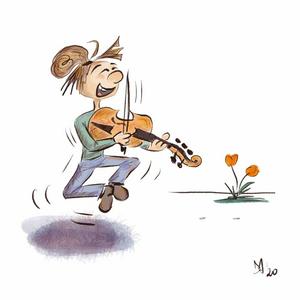How it’s made: part 13 - nailing the neck!
Sorry, I played a bit with silly app sound effects. 😅I didn’t do that fancy thing, hammering a red-hot nail into the neck, and I will tell you why.My nails are hand-forged by Adelheid Snell, a Dutch lady blacksmith. I am grateful for including a piece of art by someone else in my instrument.It’s a bit difficult to write in a foreign language about someone you never met in person and still convey the emotions of your virtual acquaintance, so to avoid the risk of a dull, affected tone, I decided to veer towards a dry list of the things about this person that made me want to relate with her. I contacted her on Instagram, hoping she would want to be part of my projects.At the time, I was making an instrument for the first Women Luthiers exhibition, which was to be held in Atlanta, Washington and Burlington. When my eyes fell on the profile of a blacksmith woman on Instagram, I got excited and got in touch with her. Her Instagram profile is @judastojudith * She respects nature and deeply admires it, both in little details and in huge manifestations* Forging her tools gives her a feeling of deep connection with nature and the gods* She can see the word in the beauty of a piece of birch bark, enough to pick it up, bring it home and take and share pictures. I love doing the same with bark covered with colourful lichens in the autumn* She is sensitive about colours and uses them to convey her feelings* You can tell that she loves research, values preservation of old things, and knows early techniques and designs.She immediately understood what I was asking her; she had already made a few nails in the past for a viola da gamba maker. I couldn’t wait to get my custom handmade nails, and my expectations were surpassed when they also arrived in a lovely wooden and personalised box filled with straw. The nails were packed in oiled paper to ensure they won’t rust. They were very accurately made.Adelheid’s suggestion was to drill a hole into the block and the neck, of a measure not exceeding the measure of the square section of the nail, and a length about half a cm less than the nail. Then, “gently” hammer the nail in. She says handforged nails make a much stronger bond than factory nails, because of their shape and tiny irregularities.I also liked the idea of avoiding rust in my instrument, which would better preserve it for the future and reduce the pain for someone who eventually had to repair it and remove the nail.So, I decided to trust her and follow her instructions. Following the moment's inspiration, I used 1 to 3 nails in my instruments and never had trouble. To be safe, I purposely nailed them in different directions.What’s around that thing of warming the nail until it’s red hot before hammering it in the neck? Apart from the fascination of the smoke coming out, the sound of the burnt wood, the smell of the burnt wood, and the hope to get a shadow of the burn from the outer side of the neck, like we can see in some old instruments… There is a mechanical purpose. The idea starts from the fact that a handforged nail is almost pure iron. Don’t do that with a modern nail, or you will only end up burning the wood and have a larger hole that will not keep the nail in place. Pure iron is relatively soft, and when hot, it will follow the vein of the wood it’s been hammered into. So it will bend, maybe the wood will crack a bit, and the red iron will follow that crack also in the shape and fill it. When it's hot, it’s bigger and longer; when it gets cold again, it will shrink, fixing the bond. Then, it will rust, and the rust, forming like little flakes or hairs running into the wood, will grip the nail to the wood even more. Someone wanting to take it out will have a hard time.I know; it is fascinating. And I will probably do it next time. Because my Adelheid’s nails are almost finished, I think I will spare them by using only one of them with this technique.What did they do in the past?In old necks, you can find everything: hot nails, cold nails, one nail, three nails, and even no nail at all, just glue.No question is too stupid to be asked; please ask if there’s anything unclear.Feel free to interact, send comments, and ask questions. The beauty of a newsletter on Substack is that the online version can be corrected and updated, so if you feel we missed something or weren’t clear enough, or even if you find a typo or an incorrect technical term (we are not native English speakers), we will be very grateful for your advice and corrections! Thank you!As always, I am opening a thread for your questions in the private chat. See you there!Featured video of the weekBeautiful quantz trio sonata, featuring Kaga Yutaka at the continuo on the Violoncello da Spalla! Enjoy! This is a public episode. If you'd like to discuss this with other subscribers or get access to bonus episodes, visit violoncellodaspalla.substack.com/subscribe


